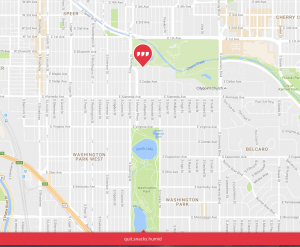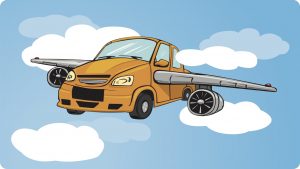Innovation & Sociology – Jobs To Be Done

Not to stay warm
Thirty years ago, I was a product manager for a startup company that created high-performance, multiprocessing minicomputers. Powerful, scalable, and based on open standards, they offered exceptional price/performance. In 1988, Electronics magazine gave its Computer of The Year award to the flagship model
As we introduced the system, we described the “ideal” customer: a medium to large organization that used Unix-based systems, and ran large database applications, especially Oracle applications. We trained the sales force, produced some modest direct mail campaigns, and launched.
Then reality set in. In the first three months, we sold about 45 machines to some 30 different organizations. We gathered data about our new customers and looked for correlations that would help us target prospective customers more precisely. We found nothing — no patterns in terms of size, SIC code, geography, application, and so on. The data were almost random.
We were stumped. So, we decided to interview the key decision maker in each account. We created an interview guide and fanned out to visit customers
After our visits, we dug into our findings. Again, we found no useful patterns in the demographic data. Then we started describing the key decision makers. Who were they? Why did they decide on us?
Most of the decision makers were men in their early thirties who had recently been promoted to a position typically described as VP, Data Processing. They replaced an older person who had held the same position for more than ten years. One of our marketers had a flash of insight: “It’s almost like the decision maker is saying, ‘I’m the new sheriff in town. We’re going to do things my way. This is one of my first big decisions … and we’re going to buy a hot new machine from a startup company. I’m going to make my mark.’”
It turned out to be a very accurate description. Nominally, our customers were buying our machines to run large applications. But psychology was perhaps more important. We estimated that roughly 60% of our customers fit the “new sheriff” profile.
We decided to market specifically to new sheriffs. We trawled through organization profiles and identified those that had a new VP of Data Processing. We sent each new sheriff a fairly intense mail campaign coupled with calls by our local sales rep. The campaign succeeded rather well. From the time of the launch, we grew to $300 million in revenue in about two years.
I didn’t know it at the time, but we were practicing an art that today is called, the “jobs to be done theory of innovation.” (Click here for a good introduction). Developed by Clayton Christensen and his colleagues, the basic idea is that demographic information doesn’t reveal why a person chooses to purchase a new product or service. If we misunderstand the job to be done, our innovations will miss the mark.
Our startup company, for instance, positioned around big machines for big databases. We wanted to offer ever bigger, pricier machines. The new sheriff profile, however, changed our thinking. To get in the door, we needed to make it easy for the new sheriff to buy something on his own authority. So, we introduced an entry-level machine priced just below a typical VP signature limit.
Similarly, think about why men buy pajamas. We might think they simply want to stay warm. But men in America typically don’t buy pajamas until they have a daughter who is three years old. Their motivation is not to stay warm but to preserve their modesty. If we misunderstand that, we’ll produce far too many cozy, warm, flannel pajamas that men will never buy.
In my experience, good marketers and salespeople use the jobs-to-be-done method naturally and intuitively. They’re good observers and naturally ask a basic question: why do people buy these products? They dig into the data but, more importantly, they observe how people behave and ask insightful questions. The management guru, Ted Levitt,was a natural at this. He noted that people don’t buy gasoline for their cars. Rather, they buy the right to continue driving.
The jobs-to-be-done theory suggests that the key to innovation is sociology, not technology. Do you want your company to be more innovative? It’s time to add more marketers and salespeople – and maybe a sociologist and anthropologist – to your development team.
Ideas and Free Throws
Assume, for a moment, that I’m your manager. I call you into my office one day and say, “You’re doing pretty good work … but you’re going to have to get better at shooting free throws on the basketball court. If you want a promotion this year, you’ll need to make at least 75% of your free throws.”
What would you do? Assuming that you don’t resign on the spot, you would probably get a basketball, go to the free throw line, and start practicing free throws (also known as foul shots). Like most skills, you would probably find that your accuracy improves with practice. You might also hire a coach or watch some training videos, but the bottom line is practice, practice, practice.
Now, let’s change the scenario. I call you into my office and say, “You’re doing pretty good work … but you’re going to have to get better at creating ideas. If you want a promotion this year, you’ll need to increased the number of good ideas you generate by at least 75%.”
Now what? Well … I’d suggest that you start practicing the art of creating good ideas. In fact, I’d suggest that it’s not very different from practicing the art of shooting free throws.
But shooting free throws and creating ideas seem to be very different processes. Here’s how they feel:
- Shooting free throws – you get a basketball, you walk to the line – 15 feet from the basket – and you launch the ball into the air. You’re conscious of every action. You recognize that you’re the cause and a flying basketball is the result.
- Creating ideas – nothing happens … then, while you’re walking down the street, minding your own business – poof! – a good idea pops into mind. You have no sense of agency. Instead of feeling like the cause, you feel like the effect.
The two activities seem very different but, actually, they’re not. In both cases, you’re doing the work. With free throws, you readily recognize what you’re doing. With ideas, you don’t. Free throws happen in your conscious mind, also known as System 2. New ideas, on the other hand, happen below the level of consciousness, in System 1. When System 1 works up an idea, it pops it into System 2 and you become aware of it.
We understand how to practice something in System 2 – we’re aware of our activity. But how do we practice in System 1? How can we practice something that we’re not aware of?
We think of our mind as controlling our body. But, as Amy Cuddy has pointed out, our bodily activities also influence our mental states. If we make ourselves big, we grow more confident. If we smile, our mood brightens.
So how do we use our bodies to teach our brains to have good ideas? First, we need to observe ourselves. What were you doing the last time you had a good idea? I’ve noticed that most of my good ideas pop into my head when I’m out for a walk. When I’m stuck on a difficult problem, I recognize that I need a good idea. I quit what I’m doing and go for a walk. Oftentimes, it works – my System 1 generates an idea and pops it into System 2.
In my critical thinking classes, I ask my students to raise their hands if they have ever in their lives had a good idea. All hands go up. Everybody has the ability to create good ideas. The question is practice.
Then I ask my students what they were doing the last time they had a good idea. The list includes: out for a walk, driving, riding in a car, bus, or train (but not an airplane), taking a shower, drifting off to sleep, and bicycling.
I also ask them what activities don’t generate good ideas. The list includes: when they’re stressed, highly focused, multitasking, overly tired, overly busy, or sitting in meetings.
So how do we practice the art of having good ideas? By doing more of those activities that generate good ideas (and fewer of those that don’t). The most productive activities – like walking – seem to occupy part of our attention while leaving much of our brainpower free to wander somewhat aimlessly. Our bodily activity influences and stimulates our System 1. The result is often a good idea.
Is that perfectly clear? Good. I’m going for a walk.
One-Day Seminars – Fall 2018
This fall, in addition to my regular academic courses, I’ll teach three one-day seminars designed for managers and executives.
These seminars draw on my academic courses and are repackaged for professionals who want to think more clearly and persuade more effectively. They also provide continuing education credits under the auspices of the University of Denver’s Center for Professional Development.
If you’re guiding your organization into an uncertain future, you’ll find them helpful. Here are the dates and titles along with links to the registration pages.
- Saturday, September 29: Critical Thinking: How To Make Better Decisions (and Avoid Stupid Mistakes)
- Saturday, October 20: Innovation: How To Create Ideas That Generate Positive Results
- Saturday, November 10: Persuasion: How To Gain Agreement and Create Successful Teams
I hope to see you in one or more of these seminars. If you’re not in the Denver area, I can also take these on the road. Just let me know of your interest.
Innovating The Innovations
Mashup thinking is an excellent way to develop new ideas and products. Rather than thinking outside the box (always difficult), you select ideas from multiple boxes and mash them together. Sometimes, nothing special happens. Sometimes, you get a genius idea.
Let’s mash up self-driving vehicles and drones to see what we get. First, let’s look at the current paradigms:
Self-driving vehicles (SDVs) include cars and trucks equipped with special sensors that can use existing public roadways to navigate autonomously to a given destination. The vehicles navigate a two-dimensional surface and should be able to get humans or packages from Point A to Point B more safely than human-driven vehicles. Individuals may not buy SDVs the way we have traditionally bought cars and trucks. We may simply call them when needed. Though the technology is rapidly improving, the legal and ethical systems still require a great deal of work.
Drones navigate three-dimensional space and are not autonomous. Rather, specially trained pilots fly them remotely. (They are often referred to as Remotely Piloted Aircraft or RPAs). They military uses drones for several missions, including surveillance, intelligence gathering, and to attack ground targets. To date, we haven’t heard of drones attacking airborne targets, but it’s certainly possible. Increasingly, businesses are considering drones for package delivery. The general paradigm is that a small drone will pick up a package from a warehouse (perhaps an airborne warehouse) and deliver it to a home or office or to troops in the field.
So, what do we get if we mash up self-driving vehicles and drones?
The first idea that comes to mind is an autonomous drone. Navigating 3D space is actually simpler than navigating 2D space – you can fly over or under an approaching object. (As a result, train traffic controllers have a more difficult job than air traffic controllers). Why would we want self-flying drones? Conceivably they would be more efficient, less costly, and safer than the human-driven equivalents. They also have a lot more space to operate in and don’t require a lot of asphalt.
We could also change the paradigm for what drones carry. Today, we think of them as carrying packages. Why not people, just like SDVs? It shouldn’t be terribly hard to design a drone that could comfortably carry a couple from their house to the theater and back. We’ll be able to whip out our smart phones, call Uber or Lyft, and have a drone pick us up. (I hope Lyft has trademarked the term Air Lyft).
What else? How about combining self-flying drones with self-driving vehicles? Today’s paradigm for drone deliveries is that an individual drone goes to a warehouse, picks up a package, and delivers it to an individual address. Even if the warehouse is airborne and mobile, that’s horribly inefficient. Instead, let’s try this: a self-driving truck picks up hundreds of packages to be delivered along a given route. The truck also has dozens of drones on it. As the truck passes near an address, a drone picks up the right package, and flies it to the doorstep. We could only do this, of course, if drones are autonomous. The task is too complicated for a human operator.
I could go on … but let’s also investigate the knock-on effects. If what I’ve described comes to pass, what else will happen? Here are some challenges that will probably come up:
- If drones can carry people as well as packages, we’ll need fewer roadways. What will we do with obsolete roads? We’ll probably need fewer airports, too. What will we do with them?
- If people no longer buy personal vehicles but call transportation on demand:
- We’ll need far fewer parking lots. How can cities use the space to revitalize themselves?
- Automobile companies will implode. How do we retrain automobile executives and workers?
- We’ll burn far less fossil fuel. This will be good for the environment but bad for, say, oil companies and oil workers. How do we share the burden?
- If combined vehicles – drones and SDVs – deliver packages, millions of warehouse workers and drivers will lose their jobs. Again, how do we share the burden?
- If autonomous drones can attack airborne targets, do we really need expensive, human-piloted fighter jets?
These are intriguing predictions as well as troublesome challenges. But the thought process for generating these ideas is quite simple – you simply mash up good ideas from multiple boxes. You, too, can predict the future.
Greetings from quit.snacks.humid

My house — quit.snacks.humid
How do you tell someone where you are? Most of us would use some form of a postal address to identify our location. But what if you’re in a place that doesn’t have a postal address? In other words … most of the world.
If there’s no postal address, I might use latitude and longitude. For instance, our home is located at 39.714549 latitude and -104.971346 longitude. If you understand the system, you’ll realize that my house is 39 degrees north of the equator and 104 degrees west of the prime meridian that passes through Greenwich, England.
(I have an 18th century French map that gives longitude as the number of degrees east or west of Paris. It was part of a long-running dispute about where, precisely, the center of the world is.)
Longitude and latitude give us precise locations, but they’re not human friendly. It’s like noting that the current temperature is 287.039 degrees Kelvin. That’s accurate but not terribly meaningful to most humans.
So, is there a way to map the world that would be easier for humans to manage? Well, how about we divide up the entire surface of the earth into squares that are approximately three meters per side? Each square is nine square meters or roughly 90 square feet. As you’ve no doubt calculated by now, we would need about 54 trillion such squares.
That may sound complicated but, really, how hard is it to manage 54 trillion squares? The researchers at What3Words – a start-up company in London – figured out that you only need 40,000 words in three-word combinations. That yields about 64 trillion combinations – enough to address the world and have a few trillion combinations left over.
In the world of What3Words, our home address is quit.snacks.humid. It’s easy to remember and precise enough to guide you to our front door. If I wanted to guide you to our driveway, I would instead use the words refuse.fake.limbs. If I wanted to send you to the highest summit in Colorado – a place that doesn’t have a postal address – I would send you to penned.metro.inspections.
According to What3Worlds, the system is already in use to deliver mail in unaddressed areas like Mongolia or the favelas of Brazil. Similarly, Steven Spielberg is using What3Words addresses to get his actors and crew to the right place at the right time as he films his latest movie. I can imagine Colorado’s Alpine Rescue Team guiding rescuers to acutely.jumbo.popcorn rather than saying, ”The injured party is about 3.3 miles northeast of the Mt. Elbert summit on the east flank of a small ravine.”
What3Words already has some interesting use cases and, if it develops fully, it should help us with logistics, emergency services, scheduling, and materials management. But its real potential comes from the fact that it’s released not as a solution but as a platform. As we know, (click here, here, and here) platforms are innovations that generate innovations. As other application developers adopt and adapt the platform, we could see a rich ecosystem of solutions that even the What3Words folks can’t imagine today.
By the way, I’m taking a few days off. If you need me, I’ll be at tent.quarrel.charm.



